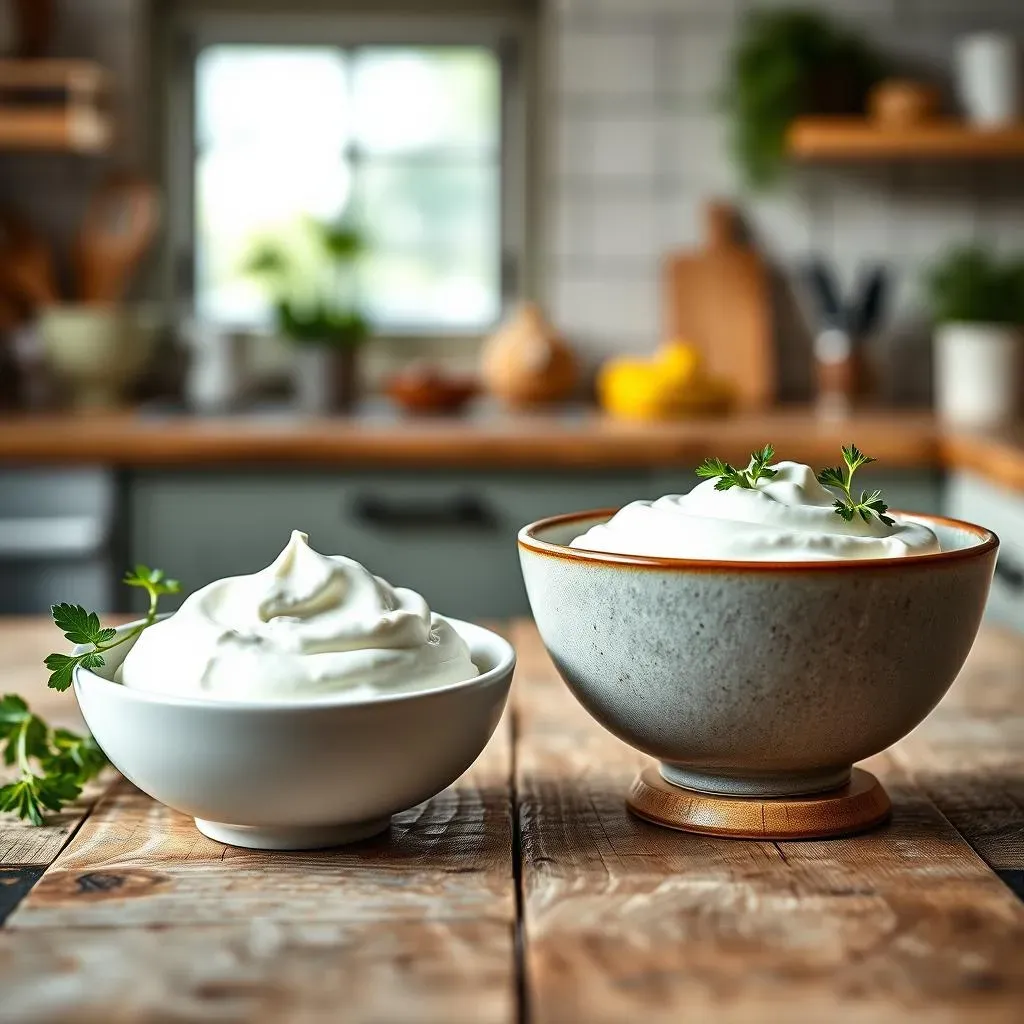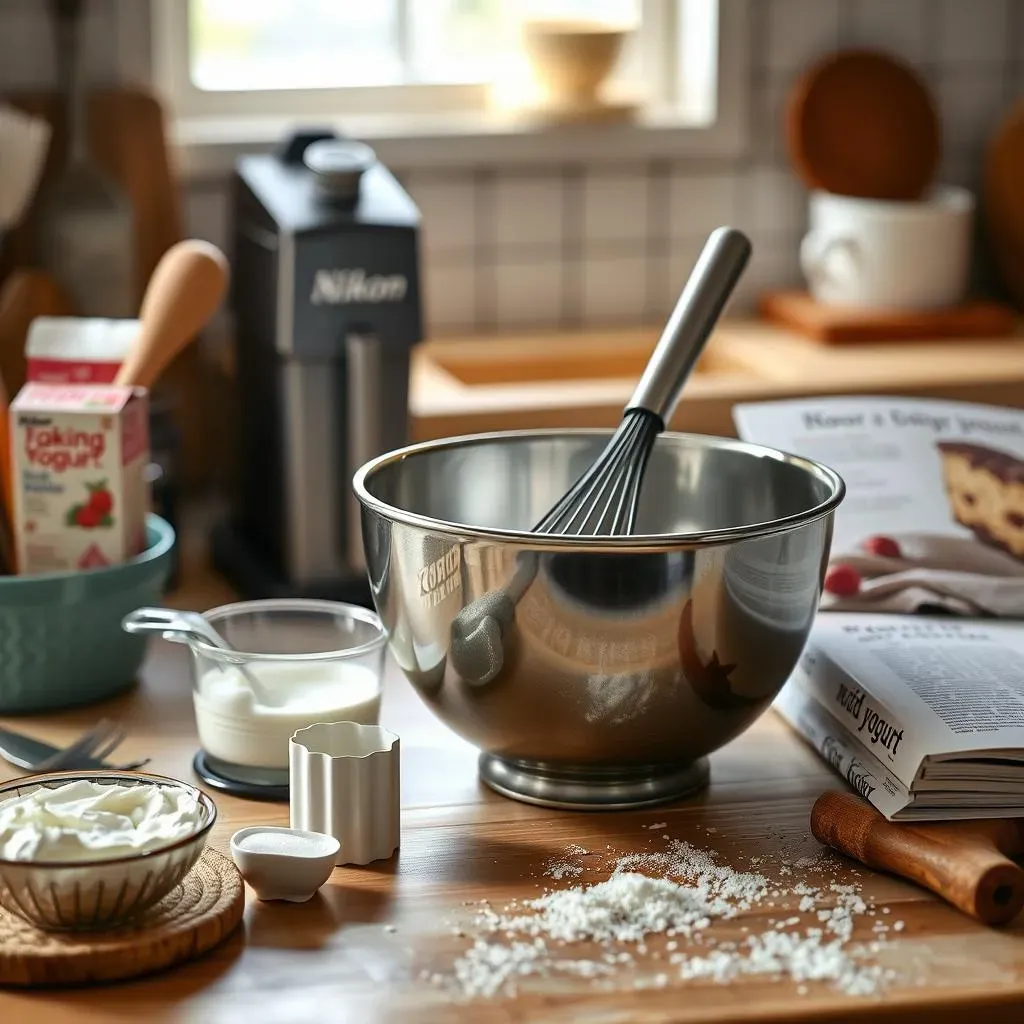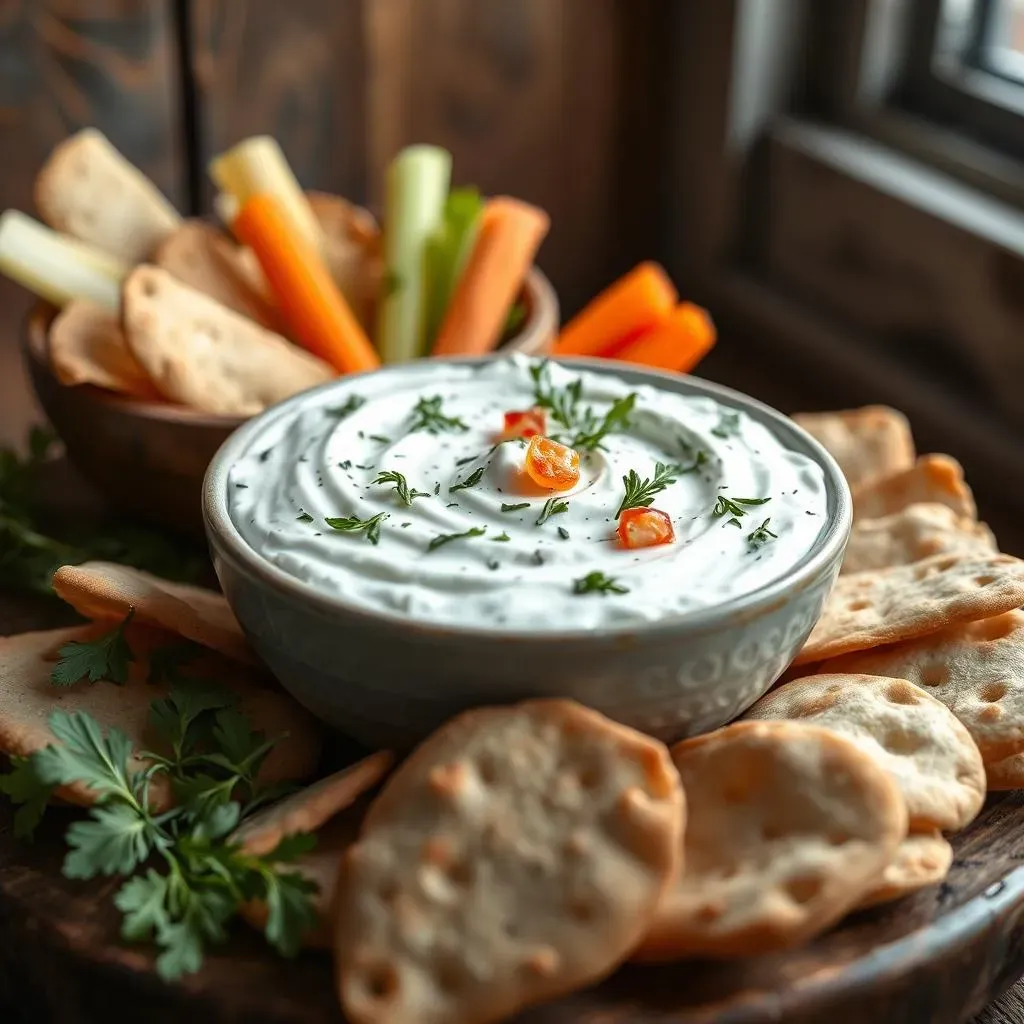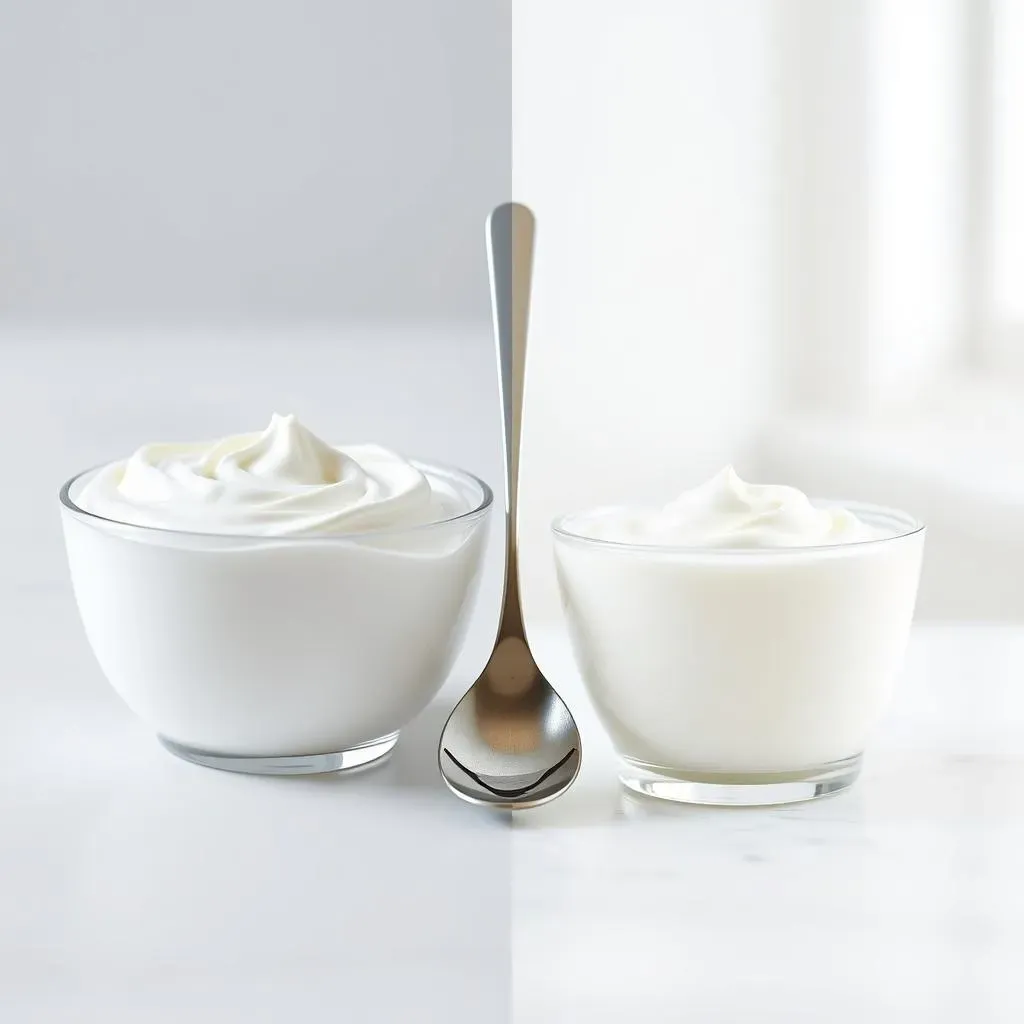Table of Contents
Ever stared blankly at a recipe, realizing you're out of sour cream? Don't panic! We're diving headfirst into the question burning a hole in many a baker's (and cook's!) mind: can plain yogurt be substituted for sour cream? This isn't just about a simple swap; it's about understanding the nuances of these two dairy delights. We'll explore whether yogurt can successfully stand in for sour cream in both sweet and savory dishes. We'll tackle baking challenges, examining whether your cake will crumble or your cookies will crack. Then, we’ll venture into the world of savory cooking, seeing how yogurt fares in dips, sauces, and other culinary creations. Finally, we'll help you choose the *perfect* yogurt – be it Greek, plain, or something else entirely – to ensure your substitution is a resounding success, not a culinary catastrophe. So, let's settle this once and for all: can plain yogurt be substituted for sour cream? Read on to find out!
The Great Yogurt vs. Sour Cream Debate: A Taste Test

The Great Yogurt vs. Sour Cream Debate: A Taste Test
Sour Cream: The Heavyweight Champion
Let's be honest, sour cream has a certain je ne sais quoi. That tangy, creamy texture? It's iconic. Think of the creamy richness in a classic potato gratin, or the tangy bite it adds to tacos. It's a versatile ingredient that brings a unique depth of flavor to countless dishes. But its high fat content is something to consider. For those watching their waistlines or cholesterol, a lighter alternative might be appealing. And that's where our challenger enters the ring.
Sour cream's versatility is undeniable. It's a star in dips, sauces, and baked goods. But let's face it, sometimes it's just not practical. Maybe you're trying to cut down on saturated fat, or maybe – gasp – you ran out! That's where the question of substitution becomes crucial. A good substitute needs to mimic sour cream's texture and tang, without significantly altering the final dish. This leads us to the next round: plain yogurt.
- Creamy texture
- Tangy flavor
- High fat content
Want to learn more about other sour cream substitutes? Check out our guide on substituting sour cream for butter.
Yogurt: The Underdog with a Punch
Plain yogurt, especially Greek yogurt, offers a surprisingly close alternative to sour cream in many recipes. It possesses a similar tanginess, and its thickness can be adjusted depending on the recipe's needs. Greek yogurt, in particular, with its thicker consistency, often works exceptionally well as a one-to-one replacement. However, the flavor profile might be slightly different, with yogurt sometimes being a little more tart and less rich than sour cream. This difference can be subtle, but it's something to keep in mind.
The beauty of yogurt lies in its adaptability. You can find it in various fat percentages, from full-fat to non-fat, giving you control over the richness of your dish. It's also generally lower in fat and calories than sour cream, making it a healthier choice for those watching their intake. However, it's important to remember that not all yogurts are created equal. The texture and tanginess can vary significantly depending on the brand and type. This is why choosing the right yogurt is crucial for a successful substitution.
Yogurt Type | Fat Content | Texture | Tanginess |
|---|---|---|---|
Plain Greek Yogurt | High/Medium/Low | Thick | High |
Plain Regular Yogurt | High/Medium/Low | Thinner | Medium |
Thinking about using Greek yogurt in your next cheesecake? Our guide on substituting Greek yogurt for sour cream in cheesecake can help.
Baking with Yogurt Instead of Sour Cream: Success Stories and Fails

Baking with Yogurt Instead of Sour Cream: Success Stories and Fails
Cakes and Cupcakes: A Sweet Success?
Let's start with the classics: cakes and cupcakes. Substituting yogurt for sour cream in these recipes often works surprisingly well. The yogurt adds moisture and a subtle tang that can complement certain flavors beautifully. Think lemon cakes or carrot cakes – the yogurt's acidity enhances the brightness of the citrus or the spice of the carrots. However, the texture might be slightly different. You might find the cake a little less dense, perhaps a bit more airy. This isn't necessarily a bad thing; it just depends on your preference. For a richer texture, full-fat Greek yogurt is your best bet. For a lighter cake, opt for a lower-fat variety. The key is to experiment and find what works best for you and your recipe. Remember, every oven and every recipe is different!
One thing to keep in mind is that yogurt can sometimes react differently with baking soda or baking powder than sour cream. It might need a little extra leavening agent to achieve the desired rise. If you're adapting a recipe, start by reducing the amount of leavening by about one-fourth and then adding more if needed. Don't be afraid to tinker with the recipe to get it just right; that's part of the fun of baking! If you're unsure about how to substitute yogurt in a particular recipe, you could always try a small test batch first.
- Experiment with different yogurt types.
- Adjust leavening agents as needed.
- Start with a smaller test batch.
Need help with baking substitutions? Check out our guide on substituting yogurt for sour cream in baking.
Cookies and Brownies: A Risky Business?
Now, let's move on to the trickier territory of cookies and brownies. These recipes are often more sensitive to ingredient changes. Yogurt's higher water content can sometimes affect the texture of cookies, making them slightly softer or more spread out than intended. Brownies, on the other hand, can become a bit too moist or even gummy if you use too much yogurt. This isn't always a disaster – some people prefer a fudgier brownie – but it's not the outcome everyone desires. The best approach here is to start with a smaller amount of yogurt than the sour cream called for, perhaps only half or two-thirds, and see how the results turn out. You can always add more later if needed, but you can't take it away.
In general, Greek yogurt works better in cookies and brownies than regular yogurt due to its thicker consistency. However, even with Greek yogurt, it's wise to proceed cautiously. If your recipe relies heavily on the fat content of sour cream for achieving a specific texture, you might find that yogurt doesn't replicate it perfectly. In such cases, you might consider using a combination of yogurt and another fat, like melted butter or oil, to compensate for the difference. It’s a balancing act, and sometimes, a little experimentation is the only way to find the perfect balance! Baking is a science, but it's also an art.
Recipe Type | Yogurt Recommendation | Potential Issues | Solutions |
|---|---|---|---|
Cookies | Greek Yogurt (full-fat) | Spread, Soft Texture | Reduce Yogurt Amount |
Brownies | Greek Yogurt (full-fat) | Gummy Texture | Reduce Yogurt Amount, Add Melted Butter |
Looking for more tips on baking substitutions? Check out our guide on substituting sour cream for plain yogurt in baking.
Beyond Baking: Using Yogurt as a Sour Cream Substitute in Savory Dishes

Beyond Baking: Using Yogurt as a Sour Cream Substitute in Savory Dishes
Dips and Dressings: A Creamy Dream?
Let's talk dips and dressings! Yogurt's tang works wonders in creamy dips like ranch or tzatziki. Greek yogurt, with its thicker consistency, is often preferred for dips, creating a richer, creamier texture. However, depending on the recipe, regular yogurt can also work well. The key is to balance the yogurt's tartness with other flavors. A little lemon juice, garlic, or herbs can go a long way in creating a delicious and balanced dip. Don't be afraid to experiment with different flavor combinations to find your perfect blend. You might be surprised at what you discover!
For dressings, yogurt can add a delightful tang and creaminess to vinaigrettes and other dressings. It's a healthier alternative to mayonnaise or sour cream-based dressings, offering a lower-fat option without sacrificing flavor. It's particularly well-suited to dressings that pair well with herbs and spices, creating a bright and refreshing taste. Again, Greek yogurt's thickness makes it a great choice for creamy dressings, while regular yogurt can work well in lighter, more vinaigrette-style dressings. Remember to taste and adjust seasoning as needed!
- Greek yogurt works best for thicker dips.
- Regular yogurt is great for lighter dressings.
- Experiment with herbs and spices to enhance flavors.
Need more ideas for sour cream substitutes? Check out our guide on substituting yogurt for sour cream in recipes.
Savory Dishes: A Culinary Adventure
Moving beyond dips and dressings, let's explore the use of yogurt in main courses. It might seem unconventional, but yogurt can add a surprising depth of flavor and creaminess to many savory dishes. Think of creamy tomato sauces, where yogurt can provide a tangy counterpoint to the sweetness of the tomatoes. It can also be used to create a delicious topping for chili, adding a cool, creamy contrast to the heat of the spices. In some curries, yogurt can mellow the intensity of the spices, creating a more balanced and nuanced flavor profile. However, remember that yogurt's acidity can curdle if added to a dish that's too hot. Always add it towards the end of cooking, or even after the dish has been removed from heat.
One area where yogurt shines is in stroganoff. The creamy texture of yogurt can provide a surprisingly good substitute for sour cream in this classic dish, often creating a lighter, less heavy version of the recipe. However, it's crucial to use a full-fat Greek yogurt to replicate the richness of the sour cream. If using regular yogurt, you might want to consider adding a little extra fat, such as a tablespoon of butter or olive oil, to compensate for the lack of richness. Remember, it's all about finding the right balance of flavors and textures to create a satisfying and delicious dish. Don't be afraid to experiment!
Dish | Yogurt Type | Tips |
|---|---|---|
Tomato Sauce | Plain or Greek | Add at the end of cooking |
Chili | Plain or Greek | Use as a topping |
Stroganoff | Full-fat Greek | Add a little fat if using regular yogurt |
Curious about other savory substitutions? See our guide on substituting cream cheese for sour cream in stroganoff.
Choosing the Right Yogurt: Greek, Plain, or Something Else?

Choosing the Right Yogurt: Greek, Plain, or Something Else?
Greek Yogurt: The Heavyweight Contender
Let's start with the champion: Greek yogurt. Its thick, creamy texture and intense tang make it a fantastic sour cream stand-in, especially in recipes where texture is key. Think dips, creamy sauces, or even as a topping for chili. The higher protein content also contributes to its thicker consistency, which helps it mimic the richness of sour cream better than regular yogurt. However, its assertive tang might not be ideal for every recipe. If you're aiming for a milder flavor, you might want to consider other options.
One thing to remember about Greek yogurt is that the fat content can vary significantly depending on the brand. Full-fat Greek yogurt will give you the richest, creamiest results, while low-fat or non-fat varieties will be lighter. Choose wisely based on your recipe and desired outcome. For instance, in baking, a full-fat option might be best for preventing dryness, while in a lighter dip, low-fat might be preferable. It really depends on your culinary goals!
- Thick, creamy texture
- Intense tangy flavor
- High protein content
- Variable fat content
Need a specific guide? Check out our guide on using Greek yogurt for sour cream.
Plain Yogurt: The Versatile All-Rounder
Plain yogurt offers a more versatile option. Its tang is generally milder than Greek yogurt, making it suitable for a wider range of recipes. The texture is thinner, though, so it might not be ideal for recipes requiring a thick, creamy consistency. You might need to strain it to thicken it up if needed, or consider using a combination of plain and Greek yogurt for the perfect balance of tang and thickness.
The beauty of plain yogurt lies in its adaptability. It comes in various fat percentages, allowing you to control the richness of your final product. For example, full-fat plain yogurt can provide a good balance of richness and tang, while low-fat options work well in dishes where you want to keep the fat content lower. It’s great for dressings, sauces, and even some baking applications. Just be mindful of the potential for a thinner texture compared to sour cream.
Yogurt Type | Texture | Tang | Best Uses |
|---|---|---|---|
Plain Regular Yogurt | Thinner | Mild | Dressings, Sauces, Some Baking |
Plain Greek Yogurt | Thick | Strong | Dips, Creamy Sauces, Baking |
Thinking about other yogurt substitutes? Check out our guide on substituting yogurt for sour cream.
Beyond Greek and Plain: Other Options
While Greek and plain yogurts are the most common choices for sour cream substitutes, other options exist. For instance, some yogurts are blended with fruits or flavors. These can add interesting twists to your dishes, but the added sugars or flavors might clash with certain recipes. Always check the ingredients to make sure the added flavors won't overpower the other elements of your dish. Also, consider the consistency of these flavored yogurts, as they may be thinner or thicker than plain or Greek versions.
Ultimately, the best yogurt for substitution depends entirely on the specific recipe and your personal preferences. Don't be afraid to experiment! Start with a small batch to test the results before committing to a full recipe. Taste as you go, and adjust accordingly. Remember, cooking (and baking) is all about having fun and creating something delicious! So embrace the experimentation and see what amazing creations you can whip up.
- Consider the added flavors and sugars in flavored yogurts.
- Experiment with different yogurt types and brands.
- Always taste and adjust as needed.
More on substitutions? Read our guide on substituting sour cream for yogurt.